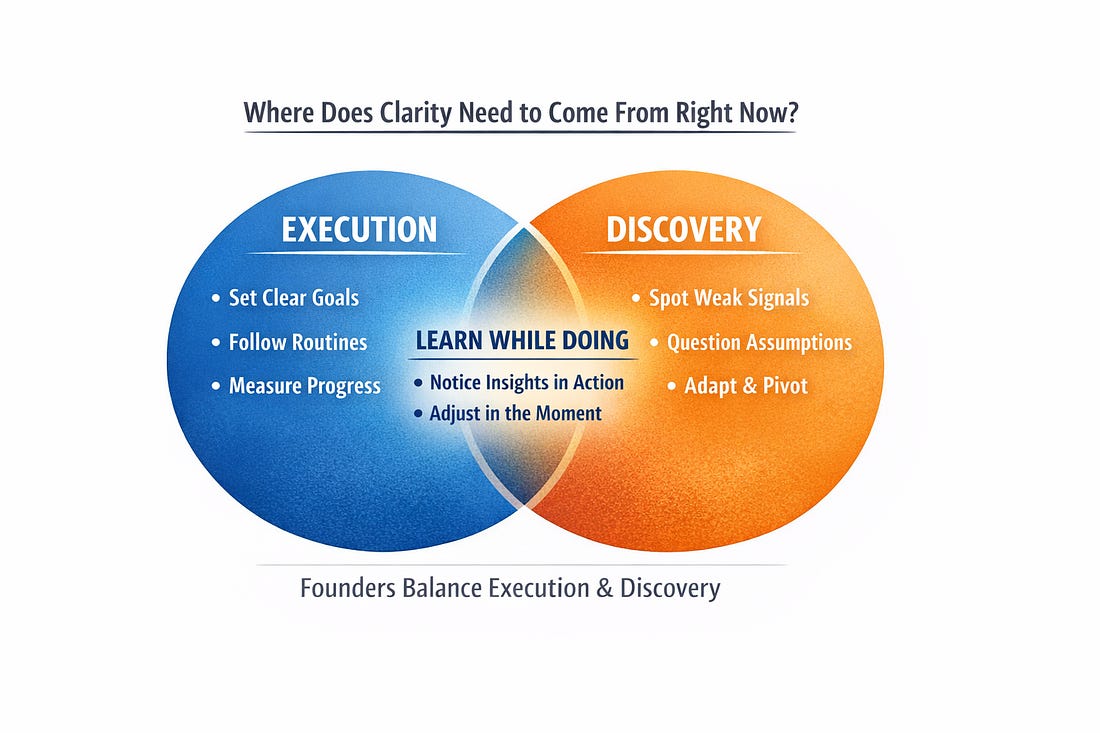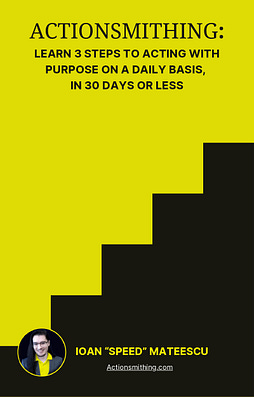Discipline Is Overrated. Spontaneity Is Underrated. Founders Need Both.Why locking in clarity too early quietly limits what founders can buildEvery founder eventually runs into this internal conflict. On one side is discipline. Planning. Structure. Consistency. The quiet pride of showing up every day and doing the work, whether it feels inspired or not. On the other side is spontaneity. Intuition. Insight. The unplanned conversation that unlocks a new direction. The idea that arrives without warning and refuses to be ignored. Most advice treats these as opposites. You are told to choose. To commit to systems. To trust process over instinct. To eliminate randomness in the name of focus. And yet, if you look closely at how meaningful companies are actually built, the story is more complicated. Discipline does not create breakthroughs. Founders need both. But not in equal measure. And not at the same time. The real skill is knowing which mode you are in, and which one the moment requires. There is a reason this tension keeps resurfacing across creative and intellectual fields. As Dorothy Parker once put it:
The line lands because it refuses the binary. The mind wanders. The eye refines - one without the other collapses. The Modern Obsession With DisciplineThe business world loves discipline because it is measurable. You can track habits. You can count hours. You can build dashboards. You can turn effort into numbers and numbers into reassurance. Discipline feels responsible. It looks like maturity. It signals seriousness to investors, teams, and even to yourself. There is a reason most founder advice eventually converges on routines. Morning rituals. Weekly reviews. Operating cadences. These things work, especially once direction is clear. But discipline has quietly become moralized. If progress stalls, the answer is assumed to be more structure. More process. Tighter goals. Better execution. Very few people stop to ask a more uncomfortable question. What if the issue is not execution at all? Discipline is powerful, but it has a blind spot. It amplifies whatever you are already doing. If the underlying assumptions are flawed, discipline helps you move faster in the wrong direction. Often, those flawed assumptions only become visible once execution is already underway. This is where founders get stuck. Some of the most successful companies avoided this trap not by abandoning discipline, but by pairing it with a willingness to question their own assumptions. Netflix is often described as an operationally rigorous company. Metrics matter. Accountability is explicit. Yet its long-term success did not come from executing the original plan more efficiently. It came from noticing when reality began to contradict that plan and responding before the data made the decision obvious. That kind of responsiveness is not accidental. It requires discipline strong enough to tolerate questioning without collapsing into chaos. What Discipline Actually Does WellDiscipline excels at execution. It creates reliability. It reduces variance. It allows work to compound over time. This is why discipline matters so much once a company has found product-market fit or a stable operating model. Psychological research supports this. Consistent routines strengthen executive control. They improve focus, reduce decision fatigue, and make progress predictable. Discipline is how effort becomes output. History is full of examples. Beethoven worked within strict compositional routines. Maya Angelou wrote on a fixed daily schedule. Edison treated invention as systematic labor rather than inspiration. None of these people waited for motivation. Discipline made their work possible. Founders need this. Without discipline, ideas remain abstract. Teams lose trust. Momentum disappears. But discipline has limits. It cannot tell you what to build. For that, founders rely on something else. What Spontaneity Actually Does WellSpontaneity is often misunderstood. It is not chaos. It is not a lack of preparation. It is not impulsiveness for its own sake. Spontaneity is responsiveness. It is the ability to notice weak signals. To connect patterns before they are obvious. To change course when reality contradicts the plan. Many of those signals appear only while the work is in motion, not before it begins. Research on creativity consistently points in this direction. Novel ideas rarely emerge from linear optimization. They arise from intersections, exposure, and attention that is not fully scripted. Sukant Ratnakar captures this dynamic succinctly:
Spontaneity, in other words, is not an escape from work. It is what happens when attention stays alive inside it. This is what allows founders to notice that a customer objection is actually a feature request. That a side project has more traction than the core roadmap. That a throwaway experiment deserves serious attention. Many of the most consequential product decisions follow this pattern. Steve Jobs was famously meticulous about execution and detail, yet deeply skeptical of market research as a source of direction. He believed customers often could not articulate what they wanted until they experienced it. Intuition sets direction. Discipline made it real. Spontaneity reveals direction. Confusing these roles creates problems. The Jazz and Classical Music ParallelThe difference between discipline and spontaneity becomes clearer outside of business. Consider classical music and jazz. Classical music is built on precision. The score is written. The interpretation is constrained. Excellence comes from rehearsal and technical mastery. Jazz sounds spontaneous. Notes bend. Tempo shifts. Musicians respond to one another in real time. But jazz is not undisciplined. Jazz musicians spend years mastering scales, harmony, and rhythm. They internalize structure so deeply that they can move freely within it. What sounds improvised is supported by deep preparation. The improvisation does not interrupt the performance. It emerges from it. This is the paradox founders often miss. Spontaneity is not the absence of discipline. Founders who lack structure cannot improvise effectively. Founders who cling too tightly to structure cannot adapt. The balance is not aesthetic. It is functional. The Cost of Premature DisciplineOne of the most common founder mistakes is applying discipline too early. In the early stages of a company, many problems are not execution problems. They are understanding problems. And that understanding often arrives through partial execution, not prior analysis. You do not yet know which customer segment matters most. You do not know which value proposition will resonate. You do not know which metrics actually reflect progress. Applying rigid discipline at this stage can lock in assumptions that should remain fluid. There is a useful parallel here from science and engineering. Engineering assumes the problem is known. The task is to build the solution efficiently. Science assumes the problem is not fully understood. The task is to explore, test, and refine hypotheses. Early-stage startups are closer to scientific exploration than engineering execution. When founders apply engineering discipline before scientific understanding, they optimize prematurely. They refine solutions to problems that have not been clearly defined. This is not a lack of discipline. It is a discipline applied in the wrong domain. Over Discipline and the Loss of IntuitionThere is another cost to over-discipline that rarely gets discussed. It dulls intuition. Founders who over-optimize structure often lose touch with the subtle signals that once guided them. They rely on metrics even when metrics lag reality. They trust process more than judgment. Those signals are rarely separate from the work. They surface while things are being built, shipped, and tested. Execution becomes excellent. Outcomes become mediocre. The company ships consistently but without insight. Meetings are efficient. Strategy feels hollow. Founders in this state often describe a sense of stagnation. Not burnout, but disconnection. They are busy, but not curious. Productive, but not inspired. This is not because discipline is bad. It is because spontaneity has been crowded out. What Mature Founders Learn Over TimeEarly founders fear chaos. They crave structure because everything feels uncertain. Later, experienced founders fear stagnation. They have seen what happens when organizations become rigid. Mature founders learn to separate execution from direction. Execution is disciplined. It benefits from routine, clarity, and accountability. Direction is exploratory. It benefits from openness, reflection, and responsiveness. This distinction changes how founders allocate their time. They protect space for thinking that does not have an immediate output. They value conversations that wander. They pay attention to what feels slightly off plan but strangely important. This is not inefficiency. It is strategic awareness. Just as jazz musicians listen to the room while playing, mature founders listen to the environment while executing. The Neuroscience PerspectiveThere is also a cognitive dimension to this balance. The brain operates using multiple networks. Two of the most relevant here are the executive control network and the default mode network. The executive control network supports focus, planning, and task execution. Discipline strengthens this system. The default mode network supports imagination, reflection, and spontaneous thought. It becomes active during rest, daydreaming, and unstructured time. Creativity emerges from the interaction between these systems. Ideas arise in the default mode. They are refined and implemented through executive control. Founders who suppress spontaneity over-engage one system at the expense of the other. The result is either scattered thinking or rigid execution. Balance is not a personality trait. It is a cognitive practice. A Simple Mental ModelThis is not a framework. It is a lens. When faced with a decision, ask one question. Where does clarity need to come from right now? Sometimes the work is pure execution. The direction is sound, but progress depends on consistency. In those moments, discipline helps. Clarify goals. Create routines. Measure progress. But often, discovery happens inside execution. You only learn what matters by doing the work. Signals emerge midstream. Assumptions surface only once they are stressed. In those moments, spontaneity is not a pause from execution. It is attention within it. The willingness to notice what the work itself is revealing. Many founder frustrations come from treating every problem as if it belongs cleanly to one mode. They force execution when the work is still teaching them something. Or they keep searching for clarity long after the signal has already appeared. Clarity does not come from choosing a mode once. It helps to visualize this not as a choice between two modes, but as an overlap where learning happens while things are being built. Execution and discovery are not separate phases. They coexist. Goals create motion, but motion creates information. The work itself becomes the source of clarity if attention is allowed to stay flexible. This idea echoes a broader truth about creative and productive work, often attributed to thinkers across disciplines:
Why This Matters More Than EverThe pace of change makes this balance increasingly important. Markets shift faster. Technology evolves quickly. Customer expectations change. Founders who rely only on discipline risk becoming efficient at outdated strategies. Founders who rely only on spontaneity risk never building anything durable. The founders who endure are those who can listen and act. Reflect and execute. Pause and commit. They build systems that support flexibility rather than eliminate it. They understand that discipline is not the goal. It is the instrument. Closing ReflectionDiscipline does not make ideas meaningful. But discipline gives structure to insight. Like jazz, what looks effortless on the surface is supported by a deep internal structure. The work of a founder is not choosing one mode forever. It is learning when to switch and having the courage to do so. It is leadership. - Before you build anything, make sure someone wants it enough to pay. I put together a free 7-day email course on revenue-first customer discovery — how to pull real buying intent from real conversations (without guessing, overbuilding, or hoping). If you’re a builder who wants clarity before code: |
Entrepreneur Examples
Tuesday, December 23, 2025
Discipline Is Overrated. Spontaneity Is Underrated. Founders Need Both.
Friday, December 19, 2025
The Action System: Turning Founder Activity Into Real Momentum (Free Resource)
The Action System: Turning Founder Activity Into Real Momentum (Free Resource)Why effort alone doesn’t move startups and what to do instead
Something shifted the way I think about founder execution. It did not come from a book or a new framework. One of those conversations was with Ioan Mateescu. What stood out was not his background in direct-response and high-growth businesses, but how clearly he articulated the gap between knowing what to do and actually doing it consistently. It is his work on action systems I am sharing here. Why startups stall even when founders work hardMost of us assume action becomes automatic once we know what to do. In reality, action is fragile. Especially in early-stage startups where feedback is delayed, confidence fluctuates, and certainty is rare. And then it leads us to a default to what feels urgent instead of what compounds. Decisions get heavier. And, we end up busy, tired, and stuck. The real bottleneckThe issue is rarely discipline. It is that daily execution is disconnected from purpose. Most founders know the long-term vision. But the connection between today’s actions and that future vision weakens over time. When that link breaks, motivation becomes unreliable. And, startups do not survive just on motivation. A different wayIoan Mateescu’s view is simple. Action does not come from motivation. Founders do not need more intensity. His framework revolves around three stages that founders often blur together.
The power is not in knowing the steps. It is in removing daily decision friction so action stops being renegotiated every morning. When founder action lacks purpose, teams lose confidence, signals get noisy, and progress feels random. The free resource for founders who feel busy but stuckHere is a simple 3-step guide that Ioan distilled this thinking into a short, focused PDF. Learn these three steps to acting with purpose daily, in 30 days or less. 📄 Access the free resource here If you want to follow Ioan’s thinking or connect directly, you can find him here. 👉 Connect with Ioan on LinkedIn Final thoughtIf you are working hard but progress feels fragile, the issue is rarely effort. It is that your actions are not anchored tightly enough to who you are becoming as a founder, where the startup is going, and how you act when certainty disappears. Fix that, and action stops feeling heavy. - Before you build anything, make sure someone wants it enough to pay. I put together a free 7-day email course on revenue-first customer discovery — how to pull real buying intent from real conversations (without guessing, overbuilding, or hoping). If you’re a builder who wants clarity before code: © 2025 Startup-Side |
Discipline Is Overrated. Spontaneity Is Underrated. Founders Need Both.
A reflective thought on why early certainty feels responsible for founders, how it quietly limits optionality, and why adaptability matters ...
-
kyungho0128 posted: "China's crackdown on Bitcoin (BTC) mining due to energy consumption concerns is widely regarded as...
-
admin posted: " A major British bank, Natwest, has put a limit on fund transfers to crypto...
-
Crypto Breaking News posted: "Mikhail Fedorov, Ukraine's Deputy Prime Minister and the head of the country's Minist...




